Reshaping Figures
For objects of different types, you can use several types of handles to reshape them.
To change the form of a figure made up of segments, you use its vertices
and adjustment handles.
To manipulate 1-D objects, you can use their endpoints.
Smart Connectors and some library objects have control handles which can
be used to adjust their position and form.
Using Vertices and Adjustment Handles
Manipulating 1D Objects
Using Control Handles
To manipulate the segments and reshape the figure, you can use the vertices and adjustment handles.
Using Vertices and Adjustment Handles
To change the form of a figure, use its vertices
and adjustment handles.
You can select these handles and reposition them thus changing the arrangement and form of
the segments constituting the figure.
To select a handle, click on it with the mouse. You can select more than one handle: hold down the Shift key as you click. The selected handles appear in magenta.
You can reposition the selected handles by dragging them with
the mouse (when the mouse cursor turns into![]() over them) or by using Shift + Arrow keys.
over them) or by using Shift + Arrow keys.
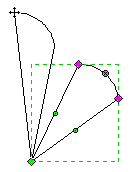
A vertex is a small diamond-shaped handle which appears in the point
where two segments meet.
To see the vertices of an object, select it with any of the segment tools:
Line ![]() , Sector
, Sector ![]() , Arc
, Arc ![]() or Spline
or Spline
![]() (you can also use the Tools / Draw menu to activate the needed tool).
(you can also use the Tools / Draw menu to activate the needed tool).
By dragging a vertex, you change the form of the object (the form and arrangement of its
segments).
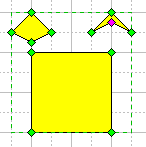
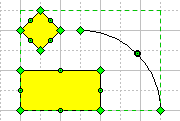
Note: By deleting a vertex, you delete the segments to which it belongs. The vertices next to the deleted one will be connected with a segment of the same type as the deleted ones (the priority is as follows: spline, arc, sector, line).
The Adjustment Handles are small round handles which appear on the
segments between the vertices.
To make these handles visible and manipulate them, you can apply the Sector
tool ![]() or the Arc
tool
or the Arc
tool ![]() .
.
The adjustment handles are used to change the curvature of the segment:
1) A line segment can be transformed in a sector of a circle by dragging its
adjustment handles with the Sector tool or the Arc tool.
2) For a segment of a circle, the adjustment handles change its curvature.
3) For an elliptic arc segment, they adjust the angle and the value of the arc
eccentricity.
4) For a spline segment, adjustment handles come associated with vertices. By
dragging these handles, you alter the curvature of the spline sections near the
corresponding vertices.
Note: For the first three segments, you can transform one into another by manipulating the handles. For instance, by dragging the adjustment handle of a line with the Sector or Arc tool, you can change it into a circular sector and then resize it into an elliptical arc segment, and vice versa.
For more information on elementary segments, refer to the "Drawing Figures" section.
Operations on Vertices and Adjustment Handles
Besides moving the vertices and adjustment handles, you can perform some additional operations on them. Both vertices and adjustment handles can be selected and deleted.
To select / unselect a vertex or an adjustment handle, just click on it. To select more than one handle, hold the Shift key down as you point and click on each additional handle. The selected handles turn magenta. Now any operation on handles will affect all the selected handles simultaneously.

If you select a vertex and reposition
it with the Shift key held down, its movement will be constrained.
The vertex will move strictly along the line coming out of the preceding vertex
at any 45 degree angle.
If the Right Shift key is pressed, the movement will be constrained with
respect to the following vertex.
To delete the selected handles, use the Del key. Deleting a handle deletes the segment with which the handle is associated.
Note: You can select and move several handles of different types at the same time. However, this works differently with the mouse and the keyboard. With the mouse, dragging affects only handles of the same type as the one you carry. That is, if you drag a rotation handle, all the selected rotation handles will move along, but the selected resize handles will stay in place. With the Arrow keys, you move all the selected handles simultaneously (the response of each hanlde will depend on its type).
Adding Vertices
You can use the Insert Vertex tool ![]() to insert an additional vertex
to a segment. Adding a vertex may be considered as dividing an existing segment into two
parts.
to insert an additional vertex
to a segment. Adding a vertex may be considered as dividing an existing segment into two
parts.
To add a vertex to a segment, activate the Insert Vertex
tool ![]() on the toolbar or
check Insert Vertex in the Tools menu.
on the toolbar or
check Insert Vertex in the Tools menu.
Select the figure, and between two existing vertices on the figure's contour, click on the
place where you want to add a new vertex. The new vertex appears and divides the segment
into two new ones.


By inserting vertices, you can also cut the lines and divide
a geometry into several ones:
hold down the Cmd (in Mac OS) or Ctrl (in Windows)
key when inserting a vertex. In this way you cut the line in the place you insert the
vertex.
For a closed figure, this operation will open it.

For an open figure, this operation will divide the geometry to which the vertex was added.

Note: To separate the geometries from each other without
reshaping them, select the figure and use the Format / Operations / Scattering
menu. Each geometry will become a separate object.
And vice versa, if you need to merge several geometries into one, superpose their
endpoints so that they form a solid path, select them all and use the Format /
Operations / Join command. See "Additional
Operations on Figures" for more detail.
Manipulting 1D Objects
Connectors and all other 1D objects have the begin point and the end point, called endpoints.

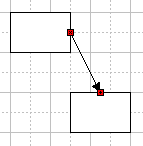
By dragging an endpoint, you resize and rotate the object at the same time.
And besides, the endpoints are capable of gluing to the connection
points of other objects, so all 1D objects can be regarded as connectors as well.
You can make any object behave as a 1D object (turn it into a connector). Select the object and call the Behavior dialog (Format / Behavior). In the Interaction style section, select Line (1-Dimensional), and the object will display the endpoints. You can use such an object as a connector.
To learn more about connectors, see the "Connectors" section.
Smart Connectors and some library objects have control handles which can be used to adjust their position and form.
Using Control Handles
The Control Handles let you adjust the form of Smart Connectors and
some library objects.
By dragging a control handle, you can change a certain characteristic of the object on
which it appears (e.g. the shape of a smart connector, the size of
a circular sector etc.).


Control handles at the ending points are capable of gluing to the connection points of other objects, the way the endpoints of connectors are:
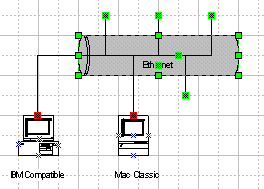
Control handles are property of library objects. You cannot create or delete them other
than from the Object Parameter Table (see the section for "Using
the Object Parameter Table").
You can also use the Object Parameter Table to add control handles to any object
you create in ConceptDraw.
See related topics:
Selecting Objects
Basic Operations on Objects
Moving, Arranging and Flipping Objects
Connecting Objects